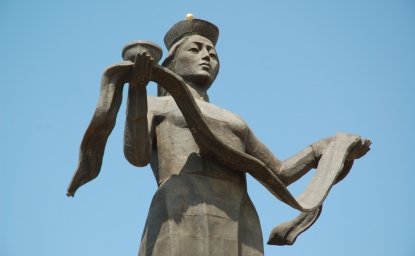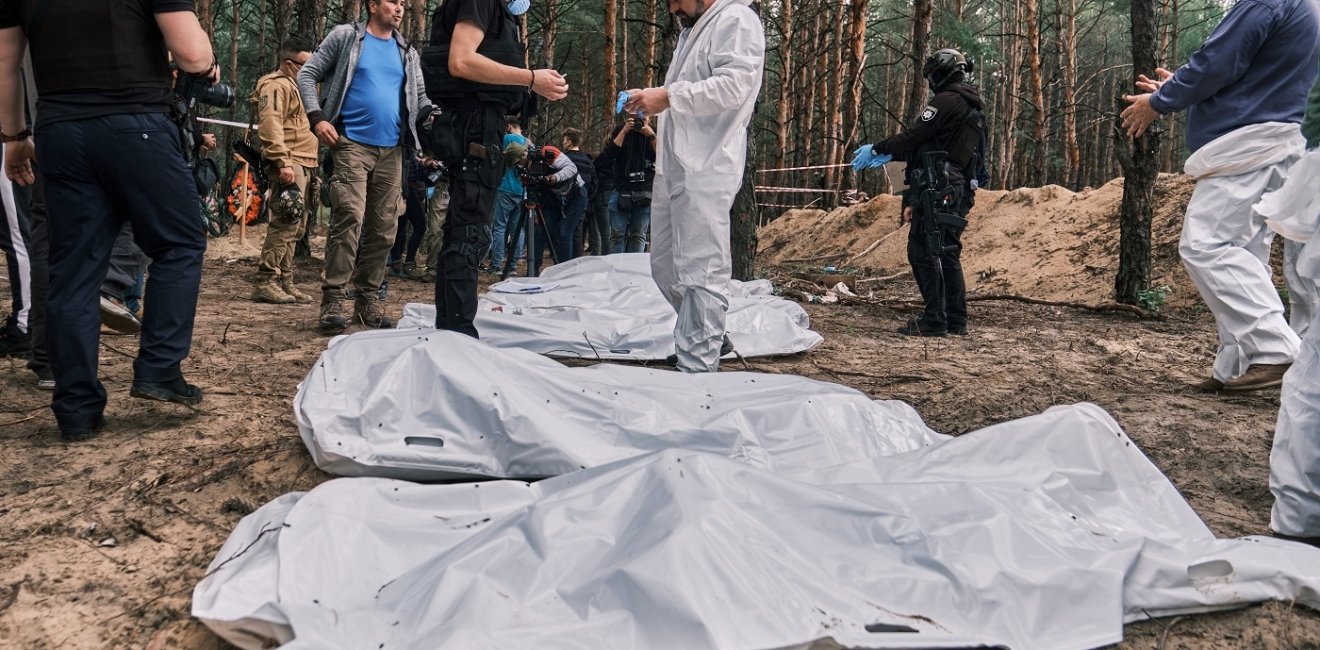
A blog of the Kennan Institute
Half a year ago, when the invasion was about to begin, a friend of mine quipped that the final goal of the enterprise was the annexation of Russia by the DNR. He meant, of course, that after the dust settled there would be 145 million Russians living in a failed state with nukes, not that the Donetsk People’s Republic would be enjoying the quality of life and the governance standards, however deficient, of a peaceful, antebellum Russia. As I write these words, Vladimir Putin has just imposed martial law on the occupied territories of Ukraine and invoked a special provision that allows it to be applied to the whole of Russia. My friend’s dark joke has come true.
The words “martial law” give some legitimacy to this state of affairs, as though these are justifiable measures reluctantly applied during hard times. But in fact, ordinary life in the occupied parts of the Donbas could only have been described as life under poorly executed martial law. Property expropriations, lawless detentions, the annihilation of whatever remnants of civil liberties there were, forced deportations—these are the realities that de facto define everyday life in the DNR and de jure constitute the new martial law.
Stage One
For all these troubles, the people of the DNR were not rewarded with economic gains. Even Russian banks and retailers preferred to keep their distance from the place, citing possible sanctions. In eight years Russia succeeded in turning a livable place into a dystopia for decades to come, a territory with no law, no economy, and half the population there used to be.
By this time everybody understands how Russia wages war: through carpet bombings, extrajudicial murders, torture, and lies. Still, there is always the distant hope that all these crimes are being done for the sake of a victory, and that when Russia gets what it wants, it will try to re-create some kind of quasi-normal, if autocratic and cruel, everyday life in the conquered territories. The excesses of war should stop at some point, and even if the perpetrators are not punished, they will come to their senses or will be replaced by civil authorities, and eventually everything will look ordinary. Judging by what we have seen so far, this hope seems ungrounded. There will never be peace in the occupied lands if they are not liberated. It is instructive to see how Russia wages peace, not war.
The process proceeds in three stages. It starts with a war. Massive civilian casualties decimate the population through murder and migration. Then the police and the security services make sure that no traces of the previous life remain, or are remembered, anymore. Finally, there comes what is supposed to be a carrot: the promise of a better life, conditional on complete loyalty. Each stage is a war in itself, though only the first stage makes it to the media’s front page.
Stage Two
Conductor Yuri Kerpatenko was shot dead by Russian soldiers in occupied Kherson for refusing to participate in a concert on International Music Day. They shot him through the door of his own apartment, as he did not want to open it. This was part of the occupying administration’s plan to hold festivities and prove to the local folks that “peaceful life is back.”
That outrageous story is just one of many. After the Russian army takes a city or even a village, siloviki—that is, members of the security forces—start kidnapping people. Local officials, businessmen, journalists—pretty much everyone who has any clout around the place. Some of these people disappear or get tortured, murdered, imprisoned, or dispossessed. And the reason for this is not just marauding, though marauding is also at play. The occupiers seek to destroy the social and political fabric of the old life because it turns out that a “Russian peace” cannot be built on that foundation. People tend to remember what the real peace looked like.
The terror can’t be explained away by the heat of the war. Crimea has been occupied for eight years now, without a war, and it is still one of the most terrorized regions under Russian control. It is one of the few places, on par with Chechnya, where forced disappearances happen routinely. The stronger the local communities, the more violence it takes to destroy them.
Then the new government comes. The newly established local elites do not even pretend to have any connection to the occupied territories. According to the investigative media outlet Proekt, 90 percent of the newly appointed officials of the conquered cities are Russian citizens and came from Russia. Many of them in their previous lives had troubles with law, which means that even the rank-and-file putinist bureaucrats are reluctant to take part in the project.
When Putin says he is willing to hold a ceasefire or negotiate, he wants to stop fighting the Ukrainian army—but not the civilians in the occupied territories. They will still be fair game, ceasefire or not, because in his eyes the peacebuilding looks like this. The existing society must be destroyed before stage three of the peace begins.
Stage Three
A few days ago, as Russian artillery was shelling cities all over Ukraine, the Russian master plan for the development of Mariupol was leaked to the press. It was devised by an institution with a characteristically unpronounceable name (the federal autonomous agency Unified Institute for Spatial Planning of the Russian Federation) under the auspices of the Ministry of Construction, Housing, and Utilities. The authors of the document are supposed to be fashionable Moscow urban planners who would never associate with ruthless artillery officers. The fruit of their labors, nonetheless, was the closest urban equivalent to carpet bombing.
The document does not mention the war, not once. It starts with the premise that there are 212,000 people in the city now, exactly half the prewar population. What happened between then and now? Nobody seems to care. Mind you, it is a master plan for development, not reconstruction, so why bother about all the people who were killed or fled? Do they come back? Do we want them to come back? What are we going to do with their property, their memories, their anger, their mourning? It is planned that there will be half a million people in Mariupol by 2035, so there has to be a way to fill the void. It is not mentioned explicitly, but an experienced urban planner of Soviet provenance can read between the lines: the population is to be resettled from another place.
Mariupol used to be home to large industrial facilities, including the famous Azovstal steel works. For better or for worse, Azovstal does not exist anymore. But not to worry, it will be rebuilt, and not only that, it will be turned into a “technopark.” We are also building a yacht club right next to it. It too will be called Azovstal. The plan does not delve into complicated questions of who will work at the new factory, or who will buy the metal from Azovstal, or how the bloodshed that happened there a few months ago will affect the output. Still, there will be a marina.
The thirty-slide document draws a bright picture of the city to come, complete with public spaces, social infrastructure, electric transport, dedicated bike lanes, and proposed color schemes for those rebuilt houses of the future. There’s just one glaring omission in the master plan: the people. The authors of the document seem pretty content with the idea that Mariupol’s future inhabitants will be completely different people. In fact, it makes their work simpler. They don’t have to deal with the inefficiencies of the past, hold public hearings, or worry about private property. They are building in a desert; half of the 2,600 houses formerly standing in the city are now destroyed.
There used to be heated, if somewhat academic, discussions in Moscow over the years about the meaning of urban planning in an unfree city. Is it necessary to decorate central squares that are usually filled with heavily armed riot police? Is it okay to devise digital control systems for public transport that are meant to create safety but are used to detain activists? Now the debate is settled. Urban planning in Russia does not cope reluctantly with the police state, it happily benefits from violence.
Back in March, when Mariupol was still being shelled, Ukrainian oligarch and former head of Donetsk oblast Serhiy Taruta nicely captured the essence of Russia’s war strategy. “They just destroy everything,” he said, “so they can put their flag above the ruins.” The thing is, that is not only a war strategy, it is a peace strategy, too.
There will be a yacht club in an annihilated city, but there will not be a memorial commemorating Holodomor, as it was just destroyed by the occupation forces. And memory itself will be in short supply, insofar as half the population is either dead or has fled, and the other half, under the newly imposed martial law, can be subjected to forced deportation. Mariupol will be a poster city for the way Russia wages peace, and the model for development for other regions, whether in Russia proper or in the occupied lands.
The opinions expressed in this article are those solely of the author and do not reflect the views of the Kennan Institute.
Author

Journalist; Host of “Snova Nikogda” podcast

Kennan Institute
After more than 50 years as a vital part of the Wilson Center legacy, the Kennan Institute has become an independent think tank. You can find the current website for the Kennan Institute at kennaninstitute.org. Please look for future announcements about partnership activities between the Wilson Center and the Kennan Institute at Wilson Center Press Room. The Kennan Institute is the premier US center for advanced research on Eurasia and the oldest and largest regional program at the Woodrow Wilson International Center for Scholars. The Kennan Institute is committed to improving American understanding of Russia, Ukraine, Central Asia, the South Caucasus, and the surrounding region through research and exchange. Read more

Explore More in The Russia File
Browse The Russia File
Chechnya as a Model of Modern Russia

Russia’s Indigenous Communities and the War in Ukraine

Gas and Power in a Changing US–Russia Relationship

